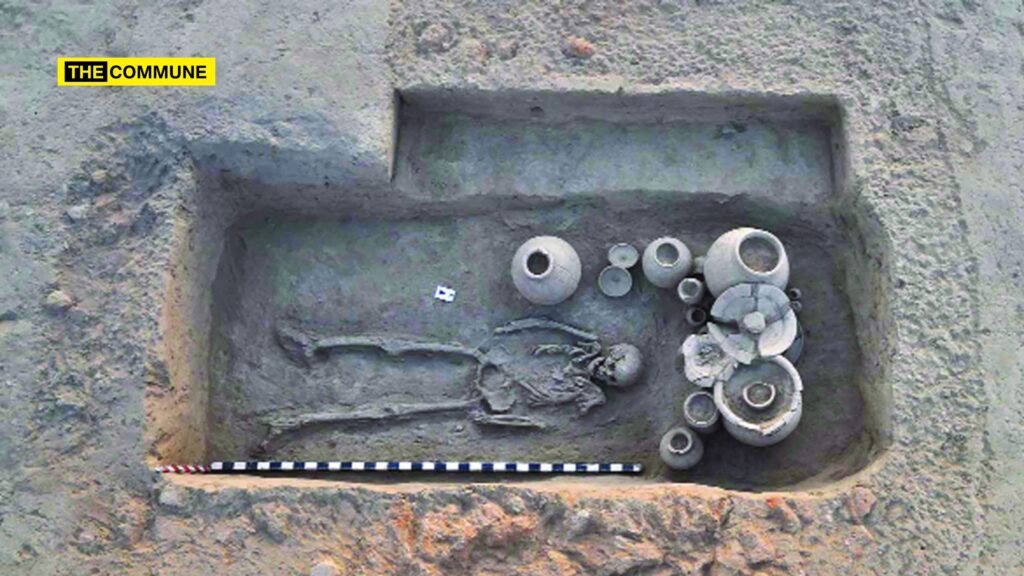Archaeological researchers from Deccan College Pune, in collaboration with the Central Archaeological Survey of India (ASI), have unveiled a remarkable discovery at the historic site of Rakhigarhi, a village situated in Haryana’s Hisar district. According to a report by Hindustan Times, the findings suggest that the human remains found at this site date back approximately 8,000 years, shedding new light on India’s ancient history. This revelation comes as a result of the third phase of excavations conducted by ASI in conjunction with multiple research teams across the country, including experts from Deccan College Pune.
The initial phase of excavations at Rakhigarhi, led by Dr. Amarendra Nath of the Indian Archaeology Department from 1997 to 2000, yielded evidence of the North Harappan culture dating back to 2500 BC. Subsequently, the second phase of excavations, led by Professor Vasant Shinde from Deccan College Pune, took place from 2006 to 2013. During this phase, Shinde’s team collected substantial evidence and conducted DNA tests, suggesting that this culture could be over 4,000 years old. Over the past two years, ASI and Deccan College Pune have jointly conducted the third phase of excavations at Rakhigarhi, led by ASI Joint Director Sanjay Kumar Manjul and Deccan College Pune Assistant Professor Prabhodh Shirwalkar.
Shirwalkar explained, “The Harappan culture comprises three parts: East Harappan, Middle Harappan, and North Harappan (Modern). The earlier two excavations found evidence of the Middle and Modern Harappan cultures dating back around 4,000 years. However, the evidence uncovered in the third phase of excavations indicates that this culture dates back 7,000 to 8,000 years. Our team is currently preparing the final report on this significant discovery.”
The ongoing research suggests that human DNA has remained relatively unchanged over the past 8,000 years, which has been determined through the examination of human remains and traps found at the site. Additionally, a substantial burial ground was discovered, containing both human and animal traps.
The ASI is actively engaged in these excavations at the Rakhigarhi archaeological site, with a primary aim to make the site accessible to the public. This involves the preservation and exposure of structural remains for future viewing and the provision of visitor amenities.
During the excavations, a wide range of metal utensils, including gold and silver artifacts, were uncovered. Shirwalkar also highlighted the discovery of old silver and copper ornaments, as well as exquisite clay pots. Notably, the remains of expansive underground settlements, featuring courtyards and drainage systems, were also revealed. These settlements included houses with two to six bedrooms, offering insights into ancient lifestyle and housing. Clothing items, such as a colorful piece of cloth, a shawl, and a skirt, were also found.
Shirwalkar emphasized the significance of this research, stating, “This study provides compelling evidence that the Harappan civilization dates back 7,000 to 8,000 years. Collaborative efforts between India’s Department of Archaeology and Deccan College have led to this conclusion, confirming the existence of an advanced civilization in our country during this ancient era, comparable to the advancements of today.”
Earlier in the year, Union Finance Minister Nirmala Sitharaman had highlighted Rakhigarhi in her 2023 budget speech. She emphasized the development of five iconic archaeological sites, including Rakhigarhi, with the construction of on-site museums. The plan aims to showcase the antiquities uncovered at Rakhigarhi, which is now recognized as the largest Harappan site spanning 350 acres, in a museum near the site, estimated to be worth ₹23 crores.
Subscribe to our channels on Telegram, WhatsApp, and Instagram and get the best stories of the day delivered to you personally.

